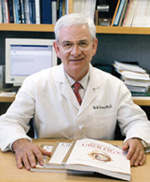New Results for Postoperative Radiotherapy
Several previous articles in QUEST and on the drcatalona.com website address
postoperative radiotherapy, but recent reports have increased our knowledge, and
this article supplements those previous ones.

History
In the past, we, and other researchers, analyzed 4-year studies of the effect of postoperative radiotherapy on recurring prostate cancer after a radical prostatectomy. The figures looked pretty good, and we reported, with some optimism, that postoperative radiotherapy worked in saving lives.
It has become clear from recent studies that some patients are far more likely to benefit from postoperative radiotherapy than others, depending upon the particular features of their tumor, their PSA level at the time of treatment, and the dose and technique of radiotherapy used.
For instance, favorable features would be a low PSA level at the time of treatment, a more slowly rising PSA level, a lower Gleason grade, and a higher dose of radiation.
Unfavorable features would be the presence of seminal vesicle invasion, lymph node metastases, a high and/or rapidly rising PSA, and a high Gleason grade. The presence of positive surgical margins has been found to be a favorable feature in some studies but not others.
Also, the duration of follow-up affects the results of postoperative radiotherapy. With longer follow-up, more patients are found to relapse.
Thus, the results of postoperative radiotherapy are strongly influenced by the patient mix. In series of patients who are selected with favorable features, postoperative radiotherapy is more successful than in those that include patients with unfavorable features. However, many patients have mixed features.
In the past, some physicians have felt that patients having certain adverse features such as lymph node metastases, seminal vesicle invasion, very high Gleason grade, or a persistently detectable or rapidly rising PSA after surgery should not be treated with postoperative radiotherapy.
Rather, hormonal therapy would be deemed more appropriate, because these patients would have a high likelihood of having distant metastases. Furthermore, to date there is no proof that postoperative radiotherapy can reduce the ultimate incidence of distant metastases or improve survival.
Recent studies have shed some new light on this controversial area of prostate cancer treatment. Although the results differ from study to study, part of the reason for these differences lie in the types of patients included, the radiation techniques used, and the length of follow-up.
Adjuvant and Salvage
Postoperative radiotherapy has two categories: adjuvant and salvage.
Adjuvant is preventive treatment closely following a radical prostatectomy. It is recommended after surgery reveals adverse pathologic findings that indicate a likely spread of the cancer beyond the prostate gland but, at the same time, the patient has an undetectable PSA.
Salvage radiotherapy is the treatment recommended when, after a RRP and upon follow-up testing, a patient has a rising PSA. It has been thought that salvage radiotherapy has the potential to cure patients with cancer recurrence after radical prostatectomy.
Stephenson Study
A recent journal article, (Stephenson, JAMA 2004) being read by doctors with a great deal of interest, reported on patients they had followed for almost four years to watch the effects of postoperative radiotherapy.
Because doctors are using the information, I think our readers should be familiar with it.
In that 4-year period, approximately 50% of patients who received salvage radiotherapy for a rising PSA after radical prostatectomy showed further cancer progression; 10% developed distant metastases, and 4% died of prostate cancer.
Factors other than a rising PSA figured into the results. Progression was more likely to occur in men with a Gleason score of 8 or more, a PSA level of 2 or higher before radiotherapy, negative surgical margins, a PSA doubling time of 10 months or less after a RRP, or seminal vesicle involvement.
The idea that negative surgical margins might be a factor in prostate cancer progression is a paradoxical finding. The proposed explanation is that patients with positive margins are more likely to have a tumor recurrence within the bed of the prostate; whereas, those with negative margins are more likely to have a distant recurrence. However, I am not convinced of this explanation, and our data does not confirm it.
Among patients with none of these adverse features present, 77% with a rising PSA after RRP remained free of cancer progression for 4 years. And some patients with only one adverse finding fared surprising well.
For instance, 64% of men with a rapid PSA doubling time remained free of recurrence for 4 years if their Gleason grade was 7 or less and their surgical margins were positive.
Also, patients with a Gleason score of 8 or higher had a progression free survival of 81% if they were treated early, had a PSA doubling time longer than 10 months and positive surgical margins.
Therefore, some patients with high-grade cancer and/or a rapid PSA doubling times who were previously thought to be destined to develop metastases may respond well to radiotherapy, at least for a 4-year period.
If Stephenson is correct, some patients with recurring prostate cancer can be optimistic that postoperative radiotherapy might, at least, postpone the spread of CaP.
Longer Study
Recently, my research group (including Dr. Misop Han, Jonathan Rubenstein, and Kimberly Roehl) updated our results analyzing the effects of postoperative radiotherapy with a longer follow-up, projected 10-year outcomes.
We found a significant decrease in progression-free rates with these longer follow-ups. In other words, the postoperative radiotherapy might not have worked as well as we thought.
In the salvage treatment setting that was recommended because of a rising PSA, we evaluated 307 patients.
Overall, PSA levels fell to undetectable in 73% of patients after radiotherapy. We observed favorable responses more often in men without seminal vesicle invasion and in those with a lower PSA at the time of treatment.
However, we did not confirm better response rates in men with positive surgical margins. In this finding, our results conflict with Stephensons.
With long-term follow-up, though, only 25% of all patients had lasting responses to salvage radiotherapy. (The 5-year response rate was 55% and 10-year rate was 35%.) It is important to note, however, that many patients with long-term follow-up were treated with older radiotherapy methods that are not as effective as those currently in routine use.
One of our conclusions is that we need more studies to answer an important question: Is postoperative radiotherapy deterring the spread of prostate cancer? In other words, how many patients would follow the same time-line with or without the postoperative radiotherapy?
In patients treated with adjuvant radiotherapy (adverse pathologic findings but an undetectable PSA), the results were that 78% were free of recurrence at 5 years and 64% at 10 years. In matched patients who did not receive adjuvant radiotherapy, 75% were recurrence free at 5 years and 50% at 10 years. Thus, there appears to be a distinct benefit for adjuvant radiotherapy with long-term follow-up.
Controversies
A current controversy is taking place over whether all men with adverse pathologic findings after radical prostatectomy should automatically receive adjuvant radiotherapy if their PSA levels become undetectable after surgery ,or whether they should follow their PSA levels and receive radiotherapy only if the PSA begins to increase.
In women with breast cancer, for which there is no sensitive tumor marker such as PSA; adjuvant radiation and chemotherapy are routinely given if the surgery reveals adverse findings. Thus, all such women would be treated as though they would have cancer progression without further treatment.
However, with prostate cancer, the PSA test provides a sensitive marker for persistent cancer, and the results of treatment appear to be nearly as good if the radiotherapy is given when the PSA just begins to rise.
Delaying therapy until the PSA rises can avoid unnecessary treatment in some patients; however, waiting until the PSA is higher than 2 ng/ml can compromise results.
Another controversy exists about whether patients with very high-risk tumors should receive hormonal therapy in conjunction with postoperative radiotherapy, and, if so, for how long should it be continued.
Studies in patients treated primarily with radiotherapy (without surgery) have shown that patients with high risk tumors respond better if they receive hormonal therapy beginning before and continuing for two years after radiotherapy.
However, it is not known if prolonged hormonal therapy is needed with salvage radiotherapy. This distinction is important because many men would prefer to avoid prolonged hormonal therapy with its associated side effects of hot flashes, sexual dysfunction, and changes in body fat and muscle distribution. The answer to this controversy is unknown and these decisions must be made on an individual basis between the patient and his physician.
Place for Optimism
Relying on postoperative radiotherapy to deter the spread of cancer may have to be revisited. But, with new and more effective detection techniques, we might not have to worry about postoperative radiotherapy. Men will be treated soon enough so that a recurrence of the cancer is unlikely. And that world is the best of all possible worlds.







